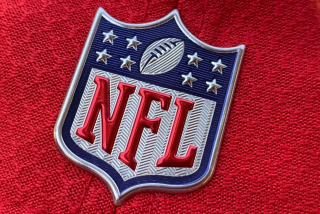Facebook’s new Sports Stadium feature gets big tryout for Super Bowl

Facebook’s Sports Stadium feature will bring together stats, videos and commentary from friends and experts in one hub. (Facebook)
- Share via
For many sports fans, scanning Twitter while watching a game goes together like guacamole and chips.
But waning interest in Twitter and its struggle to add users and captivating features has Facebook jostling to become the go-to TV companion for sports viewers.
The two social media companies will go head-to-head on Super Bowl Sunday with new “second-screen” features that they say enhance the TV-watching experience. Getting more eyeballs onto their services during the most-watched U.S. sports game of the year is also, not surprisingly, a ploy to score more advertising dollars.
Facebook will test its new Sports Stadium for the football battle. The world’s largest social network hopes that its nascent sports hub — which features statistics, videos and expert analysis — will move viewers’ rapid-fire sports chatter away from Twitter.
On Twitter, clicking the lightning bolt icon at the top of the app will lead users to a section with a highlight reel of Super Bowl tweets. Writing “#SB50,” short for Super Bowl 50, in a post automatically adds a football graphic to the message, making it more noticeable and easier for the company to sort. Tweets with “#Broncos” and “#KeepPounding” (a Panthers slogan) generate team logos.
“We’ve known for years Twitter is the largest virtual sports bar out there,” Twitter spokesman Brian Poliakoff said. “All the analysts, all the experts, all the VIPs and all your friends are on Twitter during the game.”
Twitter surely will be monitor Facebook’s Sports Stadium but declined to comment on it.
Complicated broadcast rights and other industry factors have helped sports elude cord-cutting, so most of the action still lives on traditional set-top boxes instead of online like other programming. Sports were 93 of the top 100 live TV programs in 2015, compared with 14 in 2005, measurement firm Nielsen announced this week. As a result, televised sports attracts more ad dollars than almost anything else on TV.
But there’s plenty of money to go around and social media apps want their share. Facebook and Twitter contend that advertisers can amplify the effect of TV marketing by buying ads on social media, where users already turn to discuss not just the big plays of the game but also their favorite (or most hated) ads. Television ads during sports telecasts get discussed more on social media than ads shown during any other type of programming, according to TV and social media tracking firm iSpot.tv.
Facebook and Twitter are scrambling to better serve sports viewers because advertiers gravitate toward the biggest communities.
“The Super Bowl drives an incredible amount of social media commentary,” Debra Aho Williamson, principal analyst at research firm Emarketer, wrote in a report this week. “Advertisers want to be where their audience is, and that’s in social media.”
Emarketer expects Facebook to command 65% of the $32.9 billion to be spent on social media ads this year, with Twitter next at just 9%.
The importance of sports can’t be overstated. Nearly 50% of all U.S. Twitter posts about TV shows last year referred to sports, even though sports accounted for only 1.4% of TV programming, Nielsen said.
Facebook also is a major gathering place. About 40% of Facebook’s 1.6 billion users are sports fans and tens of millions of cheers and boos flow through the app during major games, particularly as they end.
But neither has cornered the market. Just 16% of U.S. adults looked up information online last year about a sport they were watching on TV, flat from 2014, according to the Consumer Technology Assn. Only 15% of sports-TV viewers simultaneously posted about it on social media last year, steady from 2014.
The lack of growth — and the fact that three times as many general-TV viewers concurrently check social media — shows that apps have “room to innovate,” said Steve Koenig, CTA senior director of market research.
Facebook’s Sports Stadium is one attempt, currently available only on U.S. iPhones. After searching for “Super Bowl” on the Facebook app during the game, users will be able to “like,” comment on and share data about individual plays. There are also statistics as well as game-related posts from friends and “verified,” or popular, users.
“It’s a second-screen experience that we hope makes watching the broadcast even better,” Facebook product manager Steve Kafka said in a blog post.
But people complained about barren feeds and delayed stats when Sports Stadium debuted during a pair of NFL playoff games last month. Facebook expects increased marketing and support for more sports and app versions to diminish the number of kinks in coming weeks.
U.S. users spent on average of 49 minutes on the Facebook app last Super Bowl Sunday, compared with about 21 minutes on Twitter, according to 7Park Data, a research firm that tracks millions of smartphones.
To spur more engagement this year, many social media apps are stepping up their game.
Periscope and Vine — Twitter’s two video apps — have Super Bowl sections that the NFL and other popular users will help populate.
Snapchat will feature its own highlights section, with fan-shot videos that can’t be found on apps like ESPN and NFL.
And Super Bowl broadcaster CBS will be pitching its sports app during the game in hopes of attracting new users. It will have expert commentary, photos and statistics.
“We’re not foolish enough to think we’re the only place people will go, but our job is to provide content in our app that drives interest,” said Jeffrey Gerttula, senior vice president and general manager of CBS Sports Digital. “We’re seeing more consumption across every device. That’s the power of sports as a live viewing product.”
Twitter: @peard33







